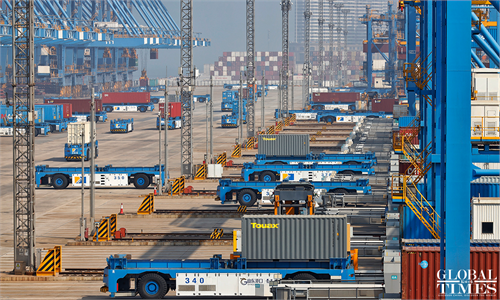
A customer browses items inside a shop of stuffed toys on February 2, 2023 in the Yiwu International Trade City in East China's Zhejiang Province. Photo: cnsphoto
A global cross-border e-commerce exhibition kicked off on Tuesday in Shenzhen, South China's Guangdong Province, amid the rising popularity of such exhibitions, where Chinese exporters explore new ways to sell overseas.
The 2023 Yuguo Global Cross-Border E-Commerce Selection Exhibition (CCEE), held from Tuesday to Thursday, will gather more than 3,000 corporate exhibitors, the CCEE's website showed.
A seller of bedside lamps with Bluetooth speakers told the Global Times that he offers a good price for every buyer.
"All products are provided with detailed pictures and videos that buyers can directly upload on their e-commerce shops. As for logistics, we ship the products directly to the end customers," the seller said.
A Zhuhai-based glassware producer told the Global Times "Surprisingly, the number of orders from Southeast Asia, such as Thailand and Malaysia, increased in 2022. We're eyeing an expansion in the Southeast Asian market."
Amid declining demand in Europe and the US, many Chinese cross-border e-commerce sellers have turned their attention to Southeast Asian markets. The region's e-commerce market is expected to reach $234 billion in 2025, with a compound annual growth rate of 18 percent, according to consulting firm Bain & Company.
"Our company saw big order increases in places like Southeast Asia and countries and regions involved in the Belt and Road Initiative," Zhu Qiucheng, CEO of Ningbo New Oriental Electric Industrial Development, told the Global Times on Tuesday.
His company's profits have continued to rise, even during the three years of the epidemic, thanks to e-commerce.
"This year, we are expanding into Latin America. We are partnering with Mercado Libre, an e-commerce brand in Latin America," said Zhu, who sees 2023 as a tough year for exporting to the US.
A manager surnamed Su of a Yiwu-based cross-border e-commerce pet product supplier told the Global Times that the company sends about 10 containers around the world every day, with shipments up by more than 10 percent on a weekly basis this year.
"Our current workshop of more than 1,000 square meters can no longer meet the production demand. We plan to build a new workshop and recruit some foreign language staffers to test cross-border e-commerce livestreaming," said Su.
As more and more Chinese enterprises rely on cross-border e-commerce, the sector has become a new engine for the nation's trade growth.
For instance, exports of e-commerce increased by 73.2 percent on a yearly basis in East China's Zhejiang Province in the first two months of 2023, according to local customs.
It is predicted that the B2B cross-border e-commerce export market will reach 13.9 trillion yuan ($2.02 trillion) in 2025, Nico Zheng, DHGATE Business Development Director, told the Global Times on Tuesday.DHGATE is the first B2B cross-border e-commerce platform in China and also a participant in the 2023 CCEE.
"Since the epidemic, face-to-face activities have been greatly affected, and communication with e-commerce enterprises and partners in the ecosystem has also been affected. The resumption of exhibitions is highly anticipated good news for the cross-border e-commerce industry, and the on-site approach will be more conducive to industry communication, product selection and information transmission," said Zheng.
Support policies have been introduced in 2023 to improve customs clearance efficiency, cultivate and expand overseas warehouses, improve logistics infrastructure, and promote the development of high-quality comprehensive pilot zones for cross-border e-commerce.
As of the end of 2022, the State Council, China's cabinet, had set up 165 comprehensive pilot zones for cross-border e-commerce, covering 31 provinces, autonomous regions and municipalities.
There are about 200,000 cross-border e-commerce enterprises in these pilot zones, statistics from the Ministry of Commerce showed.
Participants in the CCEE also told the Global Times that new e-commerce platforms, such as TikTok, Temu and Shopee, are emerging, in addition to current e-commerce giants like Alibaba and Amazon.



